Place Vendôme – The Sun King's Royal Square In Paris
Louis XIV (AKA the Sun King) may have had a bit of envie de place (square envy). After all, his grandfather Henry IV (AKA the Great Builder) was known for being… well, a builder, and had created in his short reign Europe's first public square, Place des Vosges, plus Place Dauphine on Île de la Cité. Heck, Louis' parents had even celebrated their engagement as part of the dedication ceremony of Place des Vosges. All that was a century ago and now the Sun King had been on the throne for nearly sixty years. Where was his place, his square?
![]()
Our Top-Rated Versailles Experiences
1. The Best of Versailles with Priority Access & Gardens… Our #1 choice
2. Versailles Guided Half-Day Tour with Skip-the-Line Entry… With an expert interpreter/guide
3. Full-Day Bike Tour + Skip-the-Line Chateau Access… Visit Versailles on two wheels
4. Visit Versailles + Monet's Gardens at Giverny… On one glorious day trip
Searching For a Place in the Sun (King)
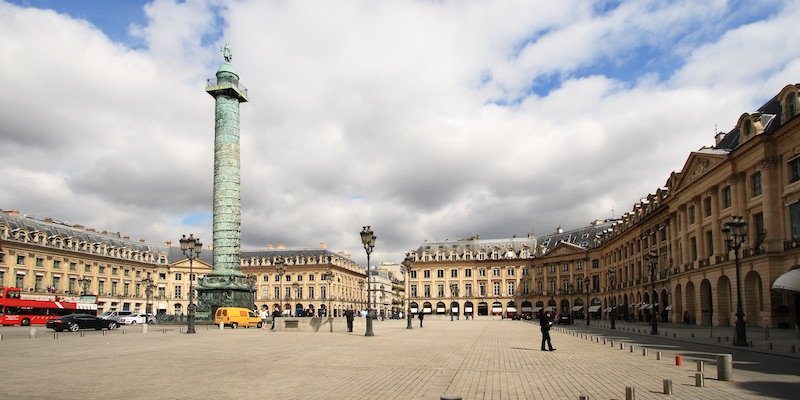 Place de Louis le Grand (Place Vendôme) as it looks today
Place de Louis le Grand (Place Vendôme) as it looks today
Or course we know that had built the magnificent chateau and gardens of Versailles, an accomplishment that today outshines much of the work of his predecessors. So, perhaps his envy wasn't as great as we imagine. What we are sure of it that Louis XIV did build a grande place in Paris in the last years of his reign and that he called it Place de Louis le Grand, today's Place Vendôme.
![]()
Discover What's On When You're Here...
• January... |
• February... |
• March... |
• April... |
• May... |
• June... |
• July... |
• August... |
• September... |
• October... |
• November... |
• December... |
Discover What's On When You're Here
• January...
|
• February... |
• March... |
|---|---|---|
• April... |
• May... |
• June... |
• July... |
• August... |
• September... |
• October... |
• November... |
• December... |
Place des Conquêtes Becomes Place Vendôme
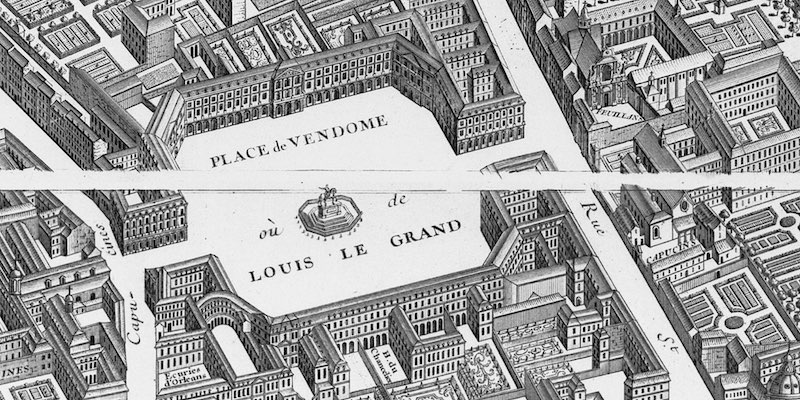 Place Vendôme, as shown on a map from 1739
Place Vendôme, as shown on a map from 1739
The idea for a grande square to honor Louis XIV goes back to about 1680 when land (and a mansion) on the Right Bank, owned by César, Duc de Vendôme, was targeted as the site. The original plan never really got off the ground, but around the turn of the century famed French architect Jules Hardouin-Mansart was brought in to design the place and the uniform facades that surround it. (César, by the way, was the illegitimate son of Henry IV and, hence, Louis' uncle.)
The square was intended to honor the victories of Louis XIV's armies. A twice-life-size equestrian statue of Louis was erected in the center and the plaza was named Place des Conquêtes, — although when the conquests didn't turn out quite the way Louis had hoped it was renamed Place de Louis le Grand.
Hardouin-Mansart relieved the corners with angled lengths of the facade to give the place an octagonal shape. You can see the shape and the equestrian statue in the above detail from a 1739 map of Paris. The map also shows how much open space, with courtyards and gardens, lies behind the imposing uniform facade.
![]()
Romantic Dinner Cruises In Paris
|
VIP Dinner Cruise with Bateaux Parisiens |
Dinner Cruise by Maxim's of Paris |
|
VIP Dinner Cruise with Bateaux Parisiens |
What Do You Find at Place Vendôme?
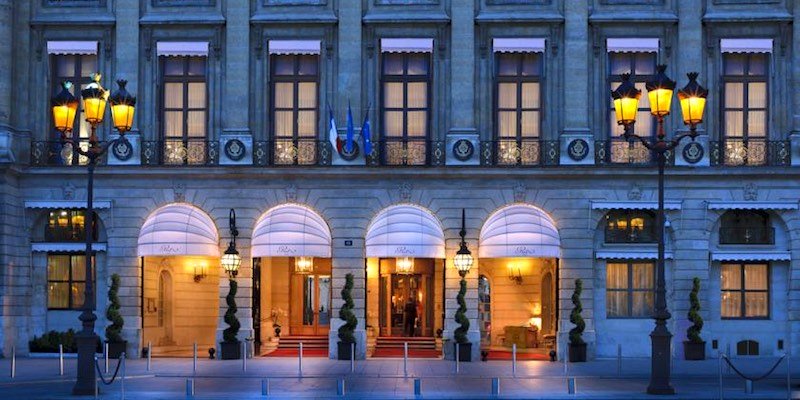 Ritz Hotel, on Place Vendôme, photo CN Traveler
Ritz Hotel, on Place Vendôme, photo CN Traveler
Initially the square attracted financiers and banks and tax offices but over the decades became the home to haute couture houses and high-end jewelers. Today there is little clothing but a lot of diamonds and luxury watches. Stores come and go (we used to shop at the now-closed Armani clothier found here), but at the time of writing the place was home to jewelers such as Mikimoto, Repossi, Dior (jewelry & watches), Chanel, and Van Cleef & Arpels. Set your time at these stores: Breguet, Piaget, Patek Philippe, Jaeger, and Rolex.
Louis Vuitton has set up shop in one corner and, across the plaza, there's the Ritz Hotel (photo above). The odd man out in this luxurious neighborhood is the French Ministry of Justice, which still has its headquarters in the building next to the Ritz.The Vendôme Column
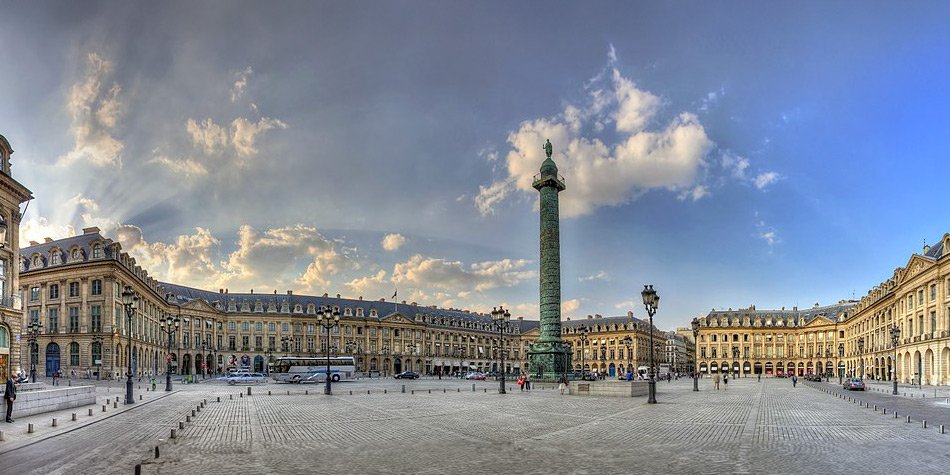 The Vendôme Column, with Napoleon Bonaparte on top. Photo Wikimedia by Giorgio Galeotti
The Vendôme Column, with Napoleon Bonaparte on top. Photo Wikimedia by Giorgio Galeotti
The equestrian statue of Louis XIV didn't survive the French Revolution of 1789, when it was pulled down and melted for scrap. (The equestrian statue of Henry IV on Pont Neuf met the same fate.) Twenty years later Napoleon used the vacant spot to erect a column celebrating his victory in the battle of Austerlitz. The stone core was encased in a bronze spiral frieze made from the 1,250 Russian and Austrian canons captured during the battle. And what did Bonaparte think would be the perfect way to cap off the 44-meter-high column? A statue of himself as a triumphant Caesar, of course.
Napoleon's reign as emperor didn't last long, and neither did his statue. Restoration king Louis XVIII removed it and replaced it with a giant fleur-de-lis, the symbol of French royalty. Napoleon's statue was melted down and the metal was used to create… a replacement equestrian statue of Henry IV on Pont des Arts, the one you see there today. The next French monarch, Louis-Philippe, re-established Napoleon on the column, this time in military uniform. Napoleon III (Bonaparte's nephew), when he came to power, substituted a replica of the original statue of Napoleon as Caesar.
![]()
Top-Rated Paris Museum Tours
|
The Louvre's Greatest Masterpieces |
Musé d'Orsay Guided Tour |
|
The Louvre's Greatest Masterpieces |
![]()
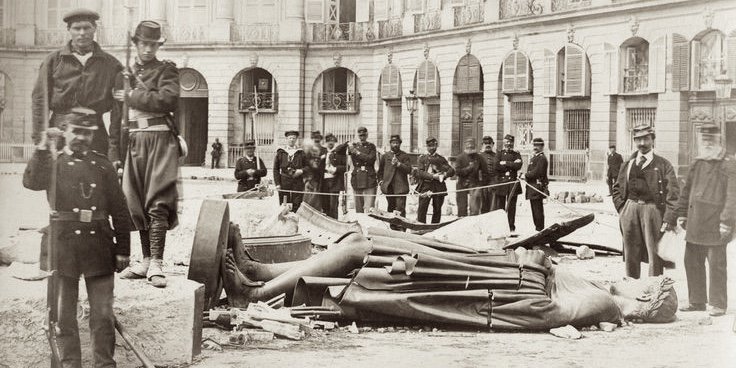 The toppled statue of Napoleon with the Communards who pulled down the column.
The toppled statue of Napoleon with the Communards who pulled down the column.
![]()
But, there's never a lack of excitement at Place Vendôme. During the Commune of 1871 — a period that managed to match the French Revolution in destruction, and do it in only a few months — the column was pulled down by a mob led by painter Gustave Courbet. After the Communards were suppressed and civic order was restored, Courbet was convicted of the destruction and ordered to pay the cost of rebuilding the column — 10,000 francs a year for thirty-three years. The painter fled to Switzerland and died there two years later, thereby saving himself 310,000 francs by our calculation. The column was restored in any case and Napoleon has been on top ever since.
![]()
Find Hotel Deals for Your Dates in Paris
Check the complete list of Paris hotels to find current sale prices on rooms in every arrondissement. Save 10%, 20%… or even more! |
Paris Hotel Deals |
Find Hotel Deals for Your Dates in Paris
Save on hotels in every arrondissement of Paris – the Latin Quarter, Saint Germain, the Right Bank, the Marais, near the Eiffel Tower. Save 10%, 20%… or even more! |
Place Vendôme Resources
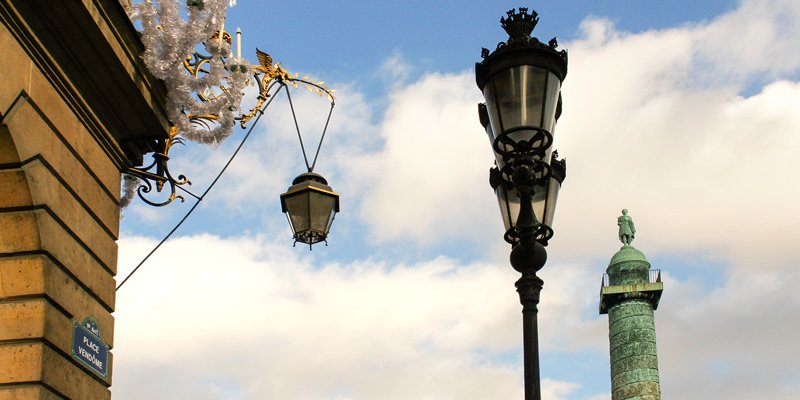
- Frédéric Chopin died at number 12 Place Vendôme in 1849.
- In the French film Place Vendôme Catherine Deneuve plays the widow of a jewel broker who is forced to rebuild the business after his suicide.
- The Ritz Hotel has been located at 15 Place Vendôme since it opened on June 1, 1898.
- Franz Mesmer, of mesmerism fame, once lived on Place Vendôme, as did fashion icon Coco Chanel (she lived at the Ritz).
- In the Gee-That's-Odd category a cupful of artist Keith Haring's cremated ashes were scattered in Place Vendôme by that queen of odd, Yoko Ono. (Keith's spirit had told her to do it. You know.)
- It's an 11-minute walk from the Arc de Triomphe du Carrousel to the Vendôme Column, which would have made it convenient for Napoleon to visit his statue when he lived at the Palais des Tuileries.
- On the front of the Ministry of Justice building, just below the window to the left of the entry is the original marble plaque displaying the length of a standard metre, mounted here in 1795 to help Parisians become familiar with the new unit of measure.
- In the earlier part of the 20th century the place was actually used an an automobile parking lot. (We suspect for the convenience of civil servants working at the Ministry of Justice.) Luckily an underground parking lot and city ordinances have eliminated the unsightly car lot.
- The left foot of the equestrian statue of Louis XIV, the only piece that remains, can be seen at Musée Carnavalet.
Paris Planning Guides
 Book an Airport Transfer
Book an Airport Transfer |
 Top Montmartre Hotels
Top Montmartre Hotels |
 Best Evenings in Paris
Best Evenings in Paris |
 VIP to Champagne
VIP to Champagne |













